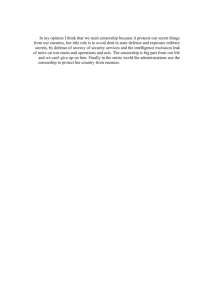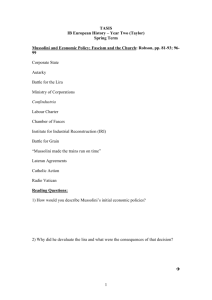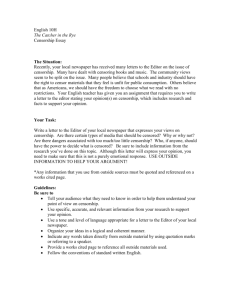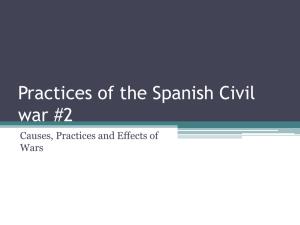PowerPoint-Präsentation
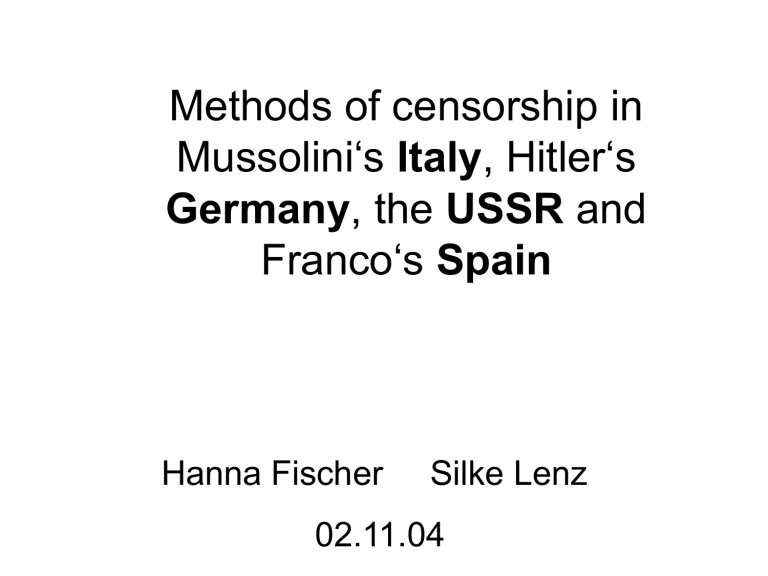
Methods of censorship in
Mussolini‘s Italy , Hitler‘s
Germany , the USSR and
Franco‘s Spain
Hanna Fischer Silke Lenz
02.11.04
Similarities and Differences between Mussolini‘s Italy and
Franco‘s Spain
Silke Lenz
Mussolini‘s Italy:
- Mussolini came into power in 1922, then he became the prime minister of Italy
- in a situation, when Italy was shattered into many different groups with many different interests in a very unstable kingdom
- Mussolini was the leader of the Fascist
Blackshirt Party
- after his March in Rome in 1922, he was invited to form a new government by king
Vittrio Emanuele III.
- Mussolini soon consolidated his power by gaining the upper hand on both king and pope
- he had been successful in improving the economy and he brought stability into the country which was needed most
„he made the trains run in time (by shooting someone, if not)“
-Mussolini first armed local fascist militia, later he formed an institutionalised militia that carried official state support
- he smashed trade unions and signed a concordate with the Vatican to fight against
Bolshewism
- Mussolini asserted his personal authority over country and party to establish a personal dictatorship, he took over many ministries at the same time (7) as well as the primership, just to give someone else power or to create a rival
Mussolini kept all power in his hand, he centralized power, and in that he became kind of an idole to Hitler and
Franco
Censorship in Italy:
- under Mussolini all communication media were under hard censorship newspaper, alswell as radiobroadcast, aswell as films
- the schoolsystem was under censorship
-all were carefully underwised to manufactor the illusion that fascism was the doctrine of the 20 th centruary, replacing liberalism and democracy
- the law codes were rewritten
- all teachers in school and university had to swear an oath to defend the Fascist regime
- newspaper editors were all personally chosen by Mussolini himself, and no one could practice journalism who did not possess a certificate of approval from the Facsist party
- the aim was to place all Italians in various professional organization or “corporations” in order to make work and money equal to avoid a new class struggle, all “corporations” under governmental control
Franco‘s Spain:
-Franco came into power in 1939 after the civil war from 1936-1939
- Franco led the Nationalist
- with the help from the German Nazis and Adolf Hitler and Italians Mussolini, he won the war and in 1939 his government was accepted by the other
European countries
- what followed was a period of 36 years of dictatorship under Generalissimo Franco, people have been supressed, trade unions were forbidden, communism was forbidden,
- between 1939 and 1943 250.000 have been killed by the regime, the only people,who profit from the regime were the big landowner, the church, the entrepreneurs, the militaries
Franco tried to establish an autarkic economy, Spain was isolated economically and politically, which led to economical crisis, inflation and poverty
in the 60 th Franco tried to enter into international negotiations, and with help of the western european countries the economical and social situation got better
in 1975 Franco died and befor he named
Juan Carlos de Bourbon to be his succsessor, Spain turned into a constitutional monarchy
under Juan Carlos turned Spain into a parliamenaly monarchy, since 1978 Spain has a democratic constitution
in 1973, when freedomhouse began its research, Spain was a not free country with less political rights and less civil liberties, in 1975 it became partly free, since 1978 Spain is a free country according to freedomhouse research
The freedom of speech and censorship under Generalissimo
Franco:
In the beginning there was no free flow of information, no freedom of expression, but a rigid system of censorship, Franco tried to use the press to substain his dictatorship, press of an instrument of government propaganda
The Press Law of 1938:
-state authority on any kind of publication
- newspapers managers and editors were determined by the state
- journalists had to be registered
- daily inspections to make sure, that there were no harmful inholds to the state
- exactly orders how informtios had to be interpreted, with specific arguments and expressions
Generalissimo Franco established a „journalist empire“ of his own
- in 1964 had been a research, which said, that only 65% of the newspaper readers believed in what was written, but only 71 out of one thousand people read newspapers
The Press Law of 1966:
censorship and the „orders“ wer relaxed
- there was no freedom of the press, but freedom of expressions
- less direct control on newspapers and publishing houses by the state a new quality of reporting on political news
But still:
-more than three formal sanctions concerning the publications of an editor could make him/her loose hies/her job
- the state retained the right to punish publishers
► so this reform was not comparable with standard of the freedom of the press in all many other western european countries, but it was seen as a partial liberalization
- there was not freedom of the press, but one right allowed the freedom of expression, which made it possible to write about formerly taboo subjekts like strikes, student protests, etc.
” Newspapers began … to perform a moderately critical role, and magazines were converted in many instances into outlet for political opinions and ideologies distinct from and sometimes contrary to those of the regime.” (Page
264)
Differences between newspaper/ radio/
TV:
-the state newspapers were alsways under heavy censorship
- in 1966 the private newspapers were under less censorship, but still
- private radio was under heavy censorship
could could only be privided by the „state radiobroadcast“ Radio International Espana
-In the beginning of the 60th television became a bigger role in society
- private commercial television was under heavy censorship
- in the late 60th and 70th it became most peoples only news source
- Franco used that as his most important instrument of propaganda
► what happened by not trusting the media, not the newspaper, not radio and not Tv in presenting free information and free news, most of the people thought every single media has the same opinion towards things that happened, people became a lack of interest in political things
► things began to change, in the 60 th , when Spain got help from the western european countries concerning economical help, and when Manuel
Fraga Iribarne relaxed the most repressive aspects of censorship and the issuance of the “orders” with the Press
Law in 1966 (Ley Fraga)
► newspaper played a very important role in the democratization of Spain. Despite there was no law that insured freedom of the press, freedom of expression was ensured by law.
So the newspaper wrote about many things concerning the western european countries, and so all other communication media helped to teach democratical norms and values to people. Soon people thought a democracy is the only way. And the fact that with help from democratic countries Spain grew economically, people wanted a democracy.
Differences between Mussolini‘s Spain and Franco‘s Italy:
- both dictatorships used the press as an instrument for state propaganda
both build up their own „empire“ of press
- communication media were under heavy censorship
- but: Franco allowed private publishing houses, newspapers, magazines, radio and tv
Conclusion:
-Media communication is most important instrument of propaganda in every authoritarian/totalitarian state
- political centralization in a authoritarian/totalitarian state goes along with centralization of the press
Comparison of all 4
Fascist states
Communisttotalitarian state
Soviet Union Italy
Nazi-Germany
Spain

